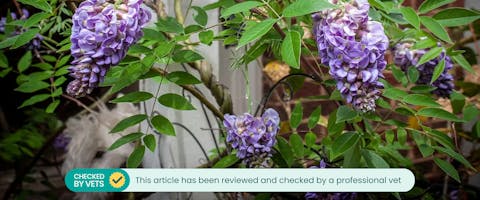Updated 11/07/2023
Favored for their pretty pink, purple, and violet blooms and their ability to instantly perk up any home or garden, it’s no surprise that wisteria is such a well-loved climbing plant (particularly amongst the most green-fingered among us).
But if you're a pet parent, it's always worth doing your research before letting your pooch loose near a new plant or flower. As we know, there are so many plants that are poisonous to dogs - is wisteria one of them?
Read on as we answer the question, ‘is wisteria toxic to dogs?’ - and reveal what to do if indeed you do catch your pooch nibbling on one.
Trending posts
Purr-use some of the top blogs our members have been loving this month- Top male dog names for your new furry friendGot a new furry family member in your pack? Check…

- Top female dog names for your new fluffy palWelcoming a new pooch into your family? Explore…

- 250+ gray cat names your silver feline will loveRecently welcomed a fluffy gray bundle of joy into…

- What are normal pet sitting rates?Discover the average pet sitting rates for animals…

- Unique dog names to stand out from the packDare to be different with our list of the best…

Are wisteria poisonous to dogs?
Yes - the wisteria plant (especially the seeds and seed pods) are toxic to dogs. They contain lectin and wisterin glycoside toxins, which can lead to a number of nasty symptoms (which we've listed down below) and can be fatal if consumed by furry friends.
Wisteria poisoning in dogs
Symptoms
Symptoms can vary depending on what part of the plant was eaten. While all parts of the plant are considered toxic, the seed pods and seeds are the most toxic, and consuming just a few seeds can cause serious harm.
According to theASPCA, the main symptoms tend to be caused by the wisterin toxin, and are mostly gastrointestinal in nature. They include vomiting (sometimes with blood), diarrhea, and depression. Your pooch may show signs of stomach pain and nausea, and dogs can rapidly become dehydrated, and progress to confusion and collapse. Not good. The lectin toxin causes clumping of blood cells, causing clotting and a possible stroke.
Related article: Is Cotoneaster poisonous to dogs?
Diagnosis
The toxins found in wisteria can make your pooch seriously ill - and it can be fatal. So if you catch (or even suspect) your pooch has been eating wisteria, it's important to get in touch with your veterinarian as soon as possible and follow their advice - whether your pooch is currently displaying symptoms or not.
If possible, bring along a piece of the plant with you. This will help your veterinarian to confirm the diagnosis, along with a thorough examination which typically includes a physical examination, a series of laboratory tests (such as an ECG, blood count, and urinalysis), along with other tests your vet deems necessary to check your dog's health and vitals.
Treatment
Treatment and recovery will depend on how much was eaten, when it was ingested, and what part of the plant your dog has consumed, as well as the outcome of your dog's examination and what your vet considers to be the best course of treatment. That said, treatment for wisteria poisoning often includes inducing vomiting to rid the system of undigested plant, and activated charcoal to absorb the toxins from the system. Fluid therapy is used to further flush the toxins and rehydrate your dog's system. Your dog may need to be kept in for observation and monitoring for at least 24 hours.
Meet our veterinary expert, Lizzie
This article has been checked by veterinarian Lizzie Youens BSc (Hons) BVSc MRCVS. Lizzie graduated from the University of Bristol in 2011, and has been working in first opinion companion animal practice. She has worked in a variety of clinics across the UK, from large hospitals to small branch practices. She enjoys doing a mixture of medicine, surgery and emergency work. Lizzie currently works in a small rural practice where she enjoys working in a close-knit community.
Other plants that are poisonous for dogs
Other than wisteria, what other plants and flowers are poisonous to dogs? Here are just a couple more to be aware of:
- Aloe
- Tulips
- Geraniums
- Peace lilies
- Chrysanthemums

